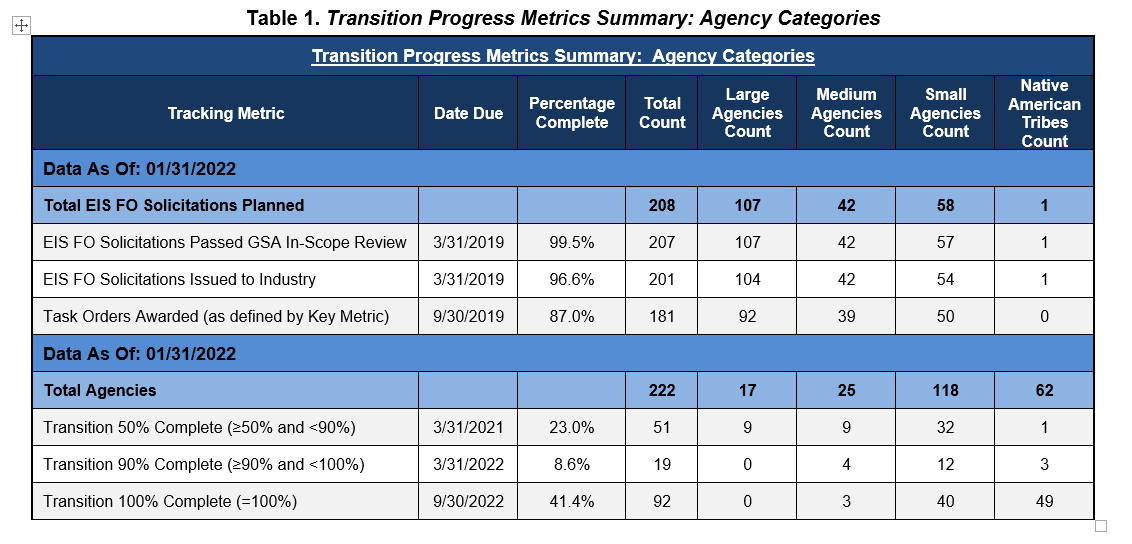 First Look
First Look  First Look
First Look Amy Haseltine, the deputy assistant commissioner for acquisitions in the Office of the IT Category in the Federal Acquisition Service, said GSA is offering a...
It’s been clear for some time that most agencies were not going to meet the March 31 deadline of moving at least 90% of their telecommunications inventory to the Enterprise Infrastructure Solutions (EIS) contract.
The General Services Administration, which oversees the EIS program, reported that as of Jan. 31 only 50%, or 111 of 222 agencies, have met the deadline. Most of those, however, are small or very small agencies.
Of the 17 large agencies, nine have met the goal of moving between 50% and 90% of their inventory to EIS. That goal, however, was for March 31, 2021.

As the next deadline nears — by Sept. 30, 2022 agencies must move 100% of all inventory to EIS — GSA is offering agencies access to new and improved tools to accelerate EIS implementation.
Amy Haseltine, the deputy assistant commissioner for acquisitions in the Office of the IT Category in the Federal Acquisition Service at GSA, said along with a host of interagency meetings, specifically with senior procurement executives, her office is bringing agencies through the RAFT — risk assessment for transition — analysis.
“It’s a project that GSA put together to leverage data analytics to help our agencies understand where they are at a point in time, and what it’s actually going to take to get where they need to go. What makes this so cool is the data analytics that we use really were derived in partnership with our industry partners on the EIS vehicle. We did some consultations with them, did some pilot testing, and ask them some foundational questions like, ‘if you have this many TDM lines, how many months is it going to take you to get to wherever you need to be?’” Haseltine said during a recent panel discussion sponsored by Granite Telecommunications and Capitol Technology University, an excerpt of which was played on Ask the CIO. “That information from our industry partners is vital because it helps give our agency customers insight into what that time is.”

She said agencies can schedule a RAFT consultation, free of charge, with GSA’s technical team and the agency’s acquisition and technology teams to take a deep dive into their current EIS transition activities.
“We provide them with an independent view, an estimate of how long it’s going to take to get them to be completed. Our goal there is not really any judgment at all, but it’s simply to give you an independent set of data that then an agency can take back and factor into their senior leadership C-suite conversations,” Haseltine said.
GSA has conducted more than a dozen RAFT consultations with agencies since last year.
Allen Hill, the deputy assistant commissioner for category management also in the Office of the IT Category at GSA, said creating that dialogue across the CIO, CFO and CAO communities as well as vendors helps to address short and long term challenges.
“From the vendor perspective, we need to understand when at the technical level where things are not going right. We’ve had agencies reach out to us and say, ‘Hey, we’re having a challenge.’ We talked with the vendors’ executives and they got in and they get them back on track. That’s extremely important to keep that dialogue going,” he said. “Those agencies who really understand at the executive level what needs to be accomplished, the resources they need to apply and the path forward to achieving the success and transition to EIS, those who understand those basics have been very successful. We’ve had agencies that have met the transition timelines and are moving forward. They’re getting those on the Federal IT Acquisition Reform Act (FITARA) scorecard. Those who are challenged, we really, really encourage them to reach out to us; let’s have those discussions.”
The RAFT exercise comes at a key time for agencies as GSA recently decided to extend the current telecommunications contracts — specifically the continuity of services (CoS) piece under Networx — because an assortment of factors was making the deadlines impossible to reach for most agencies and turning off the Networx and other legacy contracts would put their missions at risk.
GSA reported in January that agencies, mostly the departments of Defense and Homeland Security, still have to award 18 solicitations under EIS, including three that still must go to industry to bid.
This is why GSA is expanding the RAFT process.
After understanding and assessing their current status, GSA is helping agencies use their acquisition decision framework developed specifically for EIS transition. The framework also helps agencies address contingency planning and mitigation strategies as the transition to EIS takes longer than expected.
“GSA is simply trying to create a framework or a method that gives agencies ideas for how to approach acquisitions through its own lens. They’ve got limitations based on their own internal regulatory framework requirements, appropriations requirements, etc., so we’re not telling folks go left, go right, go center. But what we do want to provide them with is a decision tree that allows them to walk through it with us, if they wish, but also to allow them to walk through it with their agency C-suite executives and their broader team, so that they are empowered with all of what we know. They can then overlay that knowledge with their own agency specific sets of parameters and processes,” she said. “At least what we found so far, and it’s an incredibly enlightening discussion, time is of the essence and frankly the longer it takes for agencies to accelerate their progress, the harder it will be to get where they need to go and the more limited the choices may become in terms of designing those acquisition contingency strategies.”
She added the faster agencies go through the RAFT process, the more empowered they are then to go have other kinds of conversations within the space of their own agency.
“We recognize that given where we are, and I think this is really embracing reality, there are some agencies are going to do great and make it there are other agencies that are going to really have to push very, very, very, very hard [to meet these deadlines],” she said. “The decision framework for acquisition is really intended to give people a tool to take back and go ‘okay, now that we know where we are at this point in time, what are the 50-60 different steps that need to take place? Now that we understand our risks, what are the conversations we can have within the agency to make good choices about acquisitions so that we don’t run into the risk of having mission interrupted?’”
Hill said despite the slow progress on EIS, particularly by large agencies, there are several important trends that are emerging.
He said wireless capabilities, broadband, software-defined wide area network (SD-WAN),which is the foundation of where agency infrastructure need to move to take advantage of artificial intelligence and machine learning to address the need to surge capabilities, are among the most popular technologies in the EIS contracts.
“Some of the services we’re adding on to EIS are a secure access service edge (SASE), which is extremely important, as is that zero trust, 5G, WiFi 6 and any technology that doesn’t require that large infrastructure of technologists to support it,” Hill said. “The other dialogue we’re having with both industry and agency is that lean-forward thinking approach of how they do transition and what are the types of activities they can do now in this transition that sets them up for that future state network infrastructure and that’s necessary to support that zero trust architecture framework. That’s extremely important because if I’m putting the TDM circuit in again, I’m not moving the ball. Why do that? Let’s not make it to where we’re having to do rework, the more we do like-for-like in terms of technologies without a pathway to the to the future state, the more work we’re going to add in future modernization.”
Copyright © 2025 Federal News Network. All rights reserved. This website is not intended for users located within the European Economic Area.
Jason Miller is executive editor of Federal News Network and directs news coverage on the people, policy and programs of the federal government.
Follow @jmillerWFED
 First Look
First Look 

